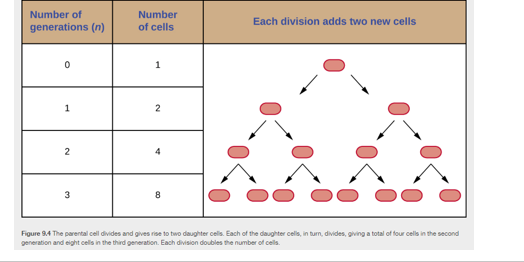Mico Genetics
1/70
There's no tags or description
Looks like no tags are added yet.
Name | Mastery | Learn | Test | Matching | Spaced |
|---|
No study sessions yet.
71 Terms
Why do we study microbial genetics?
To know & prevent diseases
To know & study Antibiotic Resistance
Biotechnology
Evolution and emerging threats of diseases
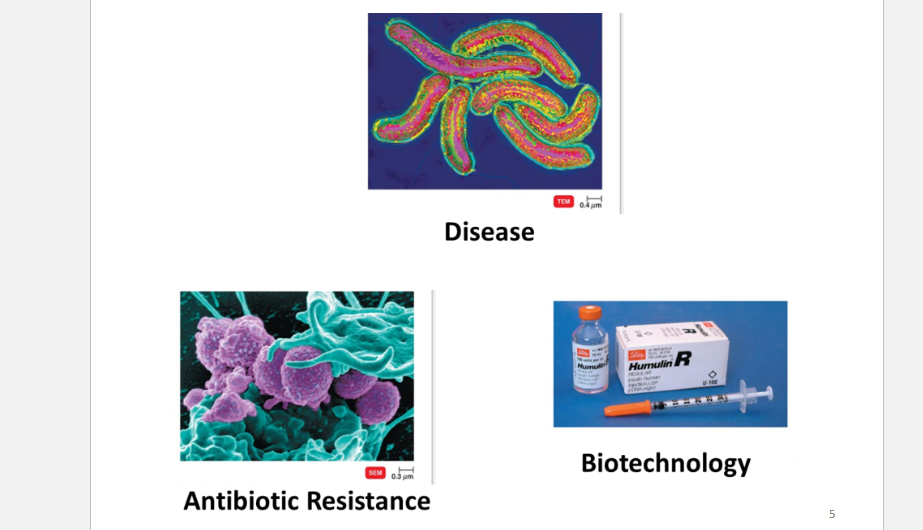
DNA Replication
Based on template and base-pairing
Double Helix
Base Pairs
DNA ( A-T & G-C) pair
RNA ( A- U & G- C) pair

Flow of Information
DNA —> RNA —> Protein
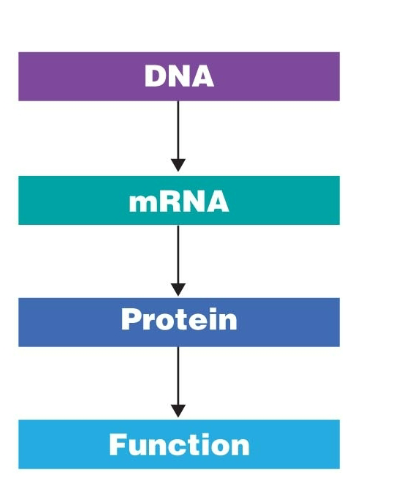
DNA Replication Structure/ Steps
1) Helicase -Separating parent DNA apart
Enzyme
2) Single Strand binding protein → Stabilizes DNA strand so they STAY APART
3) Primase - Makes short RNA Primer on DNA template
4) Topoisomerase - Relieves tension ahead of Fork (Enzyme)
5) DNA Polymerase iii - Synthesize new DNA strands on both templates
6) DNA Polymerase I - Digest RNA primers and replace with DNA
7) DNA Ligase - Connects and bonds DNA fragments together

Directions of DNA
DNA only synthesized in 5 → 3 Direction
Leading Strand (Top)
Continuous synthesis towards the fork
Lagging Strand (Bottom)
Discontinuous synthesis away from fork

What is the replication of bacteria?
Bacteria Replication chromosomes is bidrectional
Vertical Gene Transfer (for prokaryotic)
Asexual reproduction (one parent → two daughters)
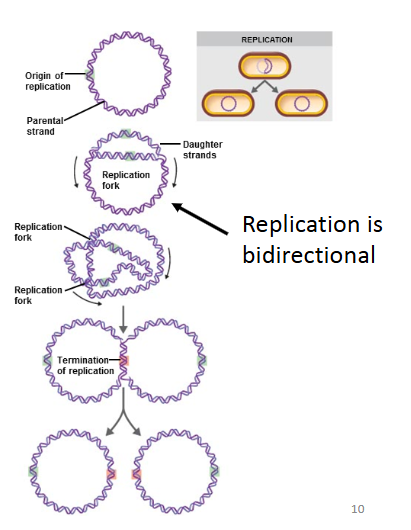
Binary Fission
is the vertical gene transfer for bacteria
“It’s the cell division for bacteria” ** KNOW THE STEPS
Chromosome replicates and divides into 2 nascent cells.
Septum grows between 2 nascent cells.
Cell wall division in the middle
Cells physically separate, producing 2 new daughter cells.
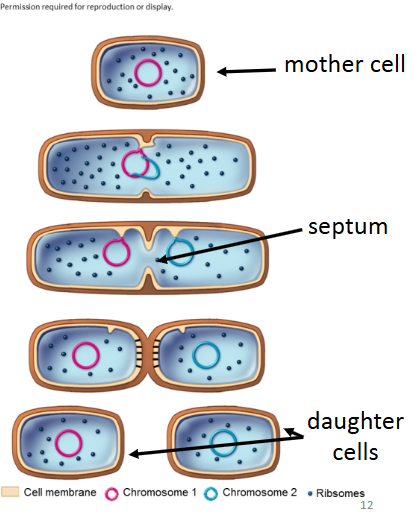
Gene Expression for Prokaryotic
Genetic information is used within a cell to produce the proteins needed for the cell function
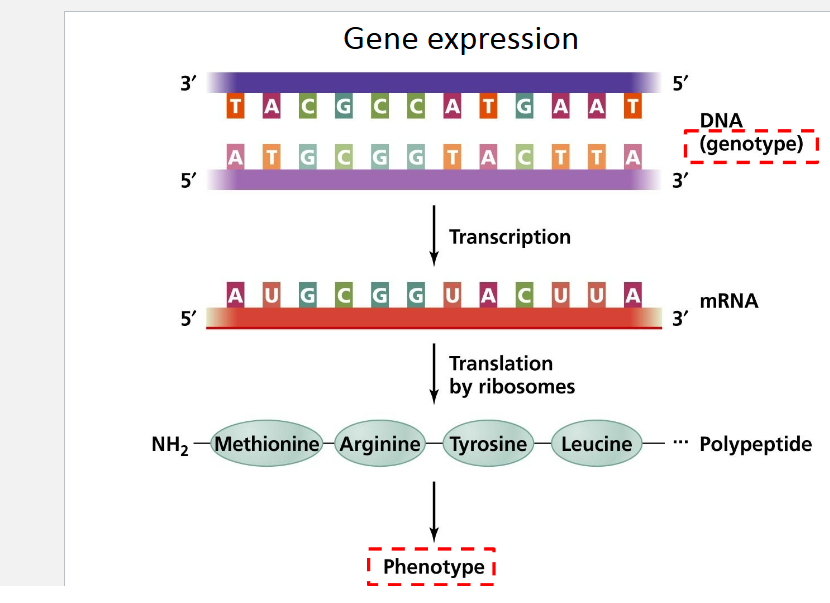
Gene Expression on Humans vs. Bacteria
Humans - Diploid 2 Sets of Chromosomes
Prokaryotes - Haploid 1 Set of chromosomes ( 1 chromosome)
Genotype
Genetic makeup
Phenotype
Physical/Observable apperance
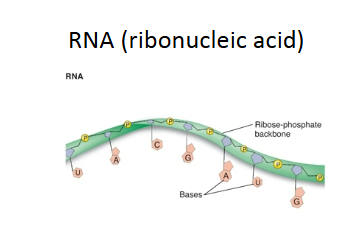
RNA (Ribonucleic Acid)
Single Stranded macromolecule
Ribose Sugar
4 Nitrogenous Base
Adenine (A)
Guanine (G)
Cytosine (C)
Uracil (U)

DNA ( Deoxyribonucleic Acid)
Double- Stranded macromolecule
Deoxyribose Sugar
4 Nitrogenous Base
Adenine ( A)
Guanine (G)
Cytosine( C)
Thymine ( T)
Transcription
DNA is read by RNA polymerase which synthesize RNA transcription in 5→ 3 direction
It adds RNA nucleotides (A, U, C, G) that are complementary to the DNA template (A pairs with U, T with A, C with G, G with C).
*DNA → RNA
(Think of it as copying a recipe from a book—DNA is the book, RNA is your copy.)
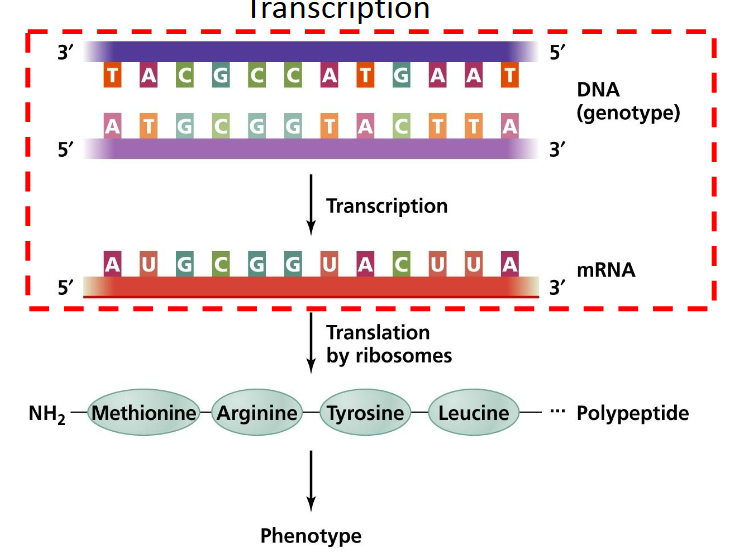
Where does transcription begin?
in : Promoter
a special DNA sequence ahead of Gene
**Transcription and Translation are coupled in prokaryotes (Happens Simultaneously)

mRna
DNA is the template for mRNA
During elongation of mRNA, one strand of DNA acts as the template strand for RNA synthesis
RNA Polymerase creates a mRNA strand that is complementary to the DNA template strand
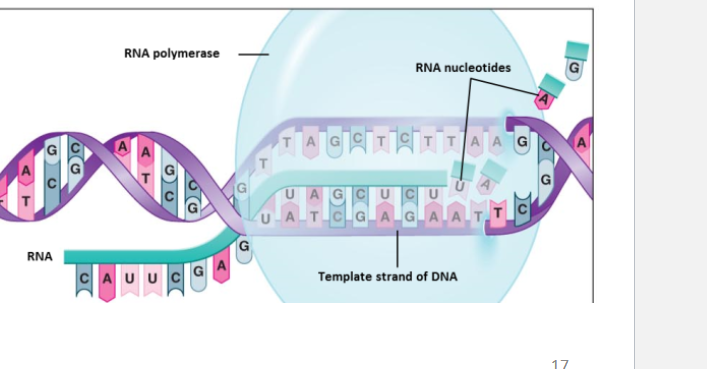
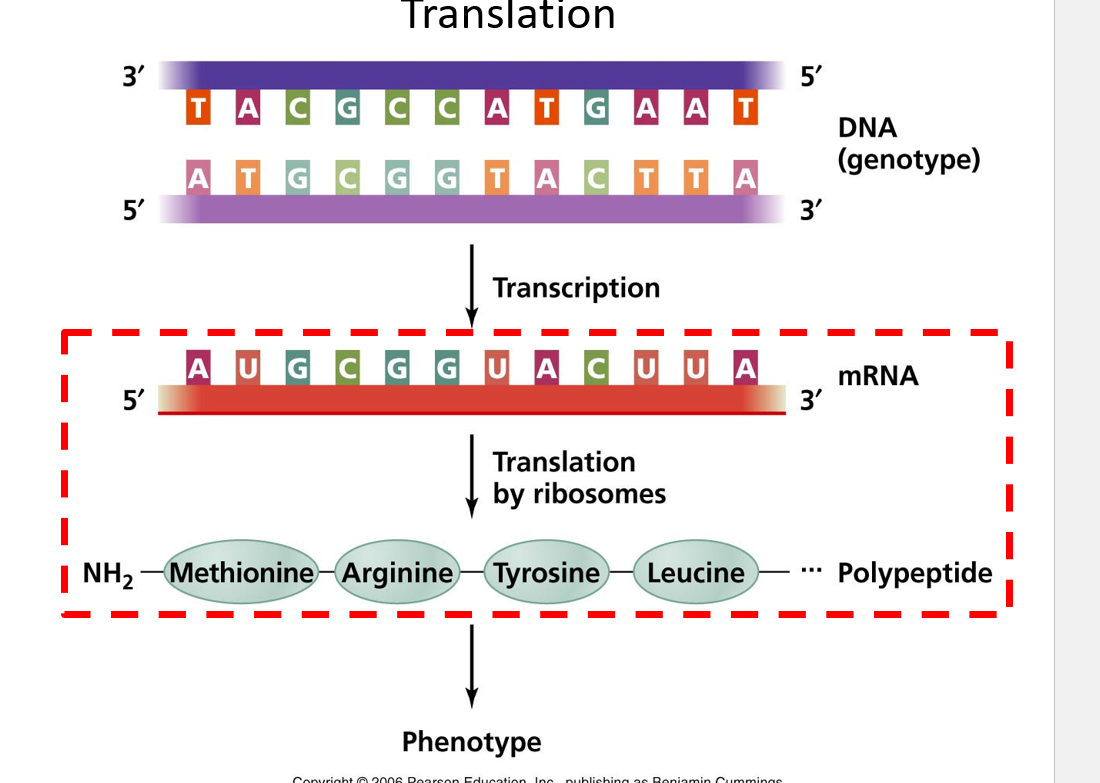
Translation RNA
Types of RNA involved in Translation:
Ribosomal RNA
Makes up ribosome which will synthesize proteins ( forms peptide bonds between amino acids)
Transfer RNA (tRNA)
RNA that brings correct amino acids to ribosomes during translation
Messenger RNA (mRNA)
RNA that carries codon info to be read by ribosome for translation
Multiple Ribosomes
Can translate one mRNA at the same time (lots of protein made in short time)
Translation
is the process where the RNA molecule is used to synthesize a specific sequence of amino acids, which then fold into a functional polypeptide (protein) from the mRNA sequence

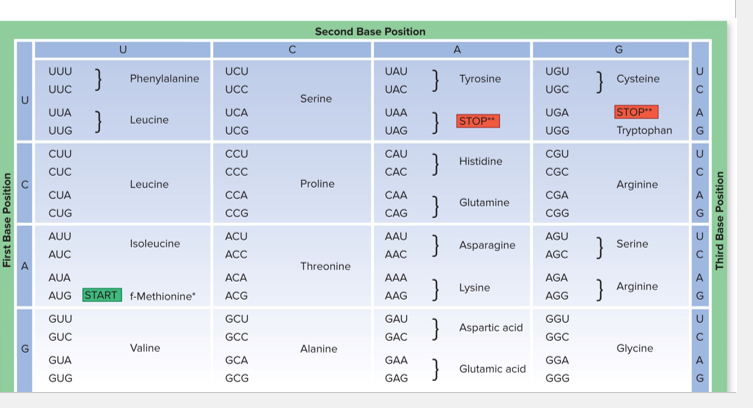
Genetic Code / Codons
is the set of three nucleotide sequences ( called CODONS) that translate genetic information (DNA/RNA) into proteins.
Multiple codons correspond to a single amino acid, result the code is redundant or degenerated
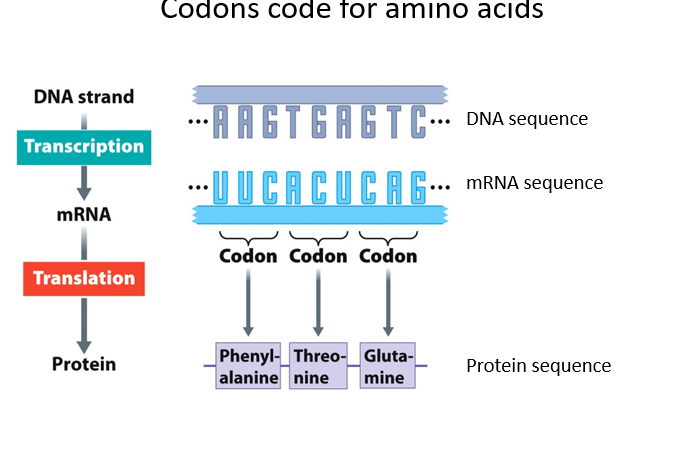
tRNA
Translation
tRNA helps link the “languages” of nucleotides and amino acids
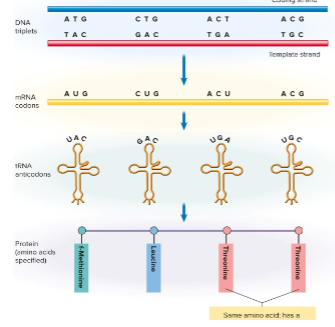
Genetic Code Read by
Read by Ribosomes
the mRNA nucleotide sequence is “read” as a sequence of codons by Ribosomes
in Prokaryotes 70s ribosomes is a large protein complex

Translation overview
Ribosomes
transfer RNA (tRNA)
Codon
Amino Acid
Genetic Code
mRNA read 5 → 3
Significance of start and stop codons
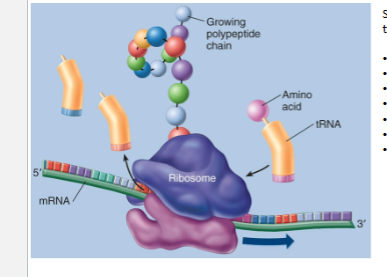
Regulation of Genes
Gene Expression in Eukaryotic cells is regulated which is particularly important for multicellular organisms in making tissue/ cells/ organs despite having same DNA
Regulation of genes in single cell prokaryotic organism is also important
Why important for Bacteria?
Controls gene expression to conserve energy ( Be more efficient)
Turning Genes on/off
ON : making mRNA transcription then translating into protein ( active)
OFF: Very little protein made (repressed)
Influence of ON/OFF Gene
Influenced Factors cause by internal and external cues
Feedback within the cell
Environmental changes ( Temp, pH, osmotic, pressure )
Chemical signals ( proteins/ molecules from other cells)
Chemical Tags on DNA
Genes are Regulated by a stimulus
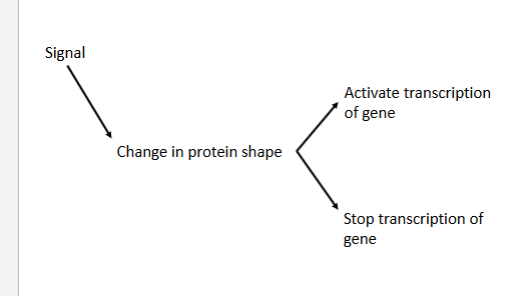
Quorum - Sensing regulates Gene
Quorum sensing is the ability of bacteria to communicate and coordinate group behavior through signaling molecules that turn ON and OFF genes
Bacteria can control gene expression base on cell concentration/density
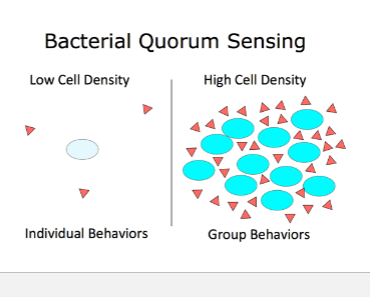
Operator
a segment of DNA that a repressor protein can bind to
controls whether transcription occurs
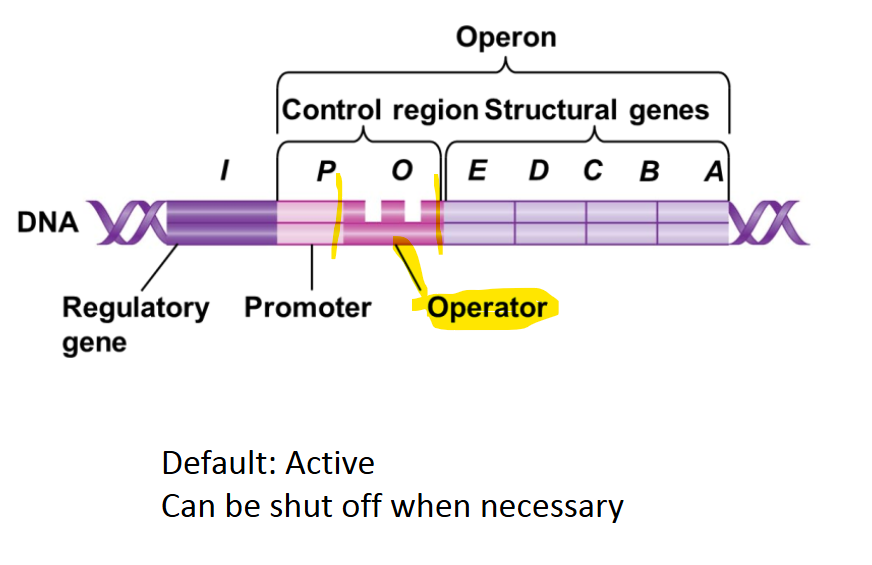
Regulatory Gene
Encodes the repressor protein that regulates the operon
** not technically part of the operon


Repressible Operon
Repressible operon is one that is normally active (transcribing genes) but can be turned OFF ( repressed) when a certain molecule is present
It’s repressible because the cell needs these genes to be "on" most of the time, but shuts them off when their product is in excess.
A corepressor, usually the end product of the operon’s pathway, binds to the repressor protein, activating it.
The activated repressor then binds to the operator, blocking RNA polymerase from transcribing the genes.
Repressor : guard that blocks the gene
Corepressor - key that activates the guard
Tryptophan - Actual thing that cell is making (product) of the operon
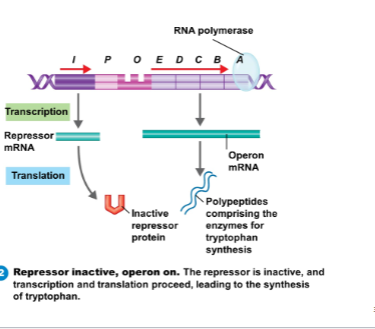
2 Types of Operons
Repressible - Default stage : On ( needs to be turned OFF when the product is already available)
Inducible - Default stage : Off ( needs to be turned ON by something)
Repressor Operon in E.coli ( TrP) Protein
synthesize tryptophan using enzymes that are encoded by five structural genes (E,D,C,B,A) located next to each other in the trp operon
When environmental tryptophan is low, the operon is turned on. This means that transcription is initiated, the genes are expressed, and tryptophan is synthesized. However, if tryptophan is present in the environment, the trp operon is turned off. Transcription does not occur and tryptophan is not synthesized.
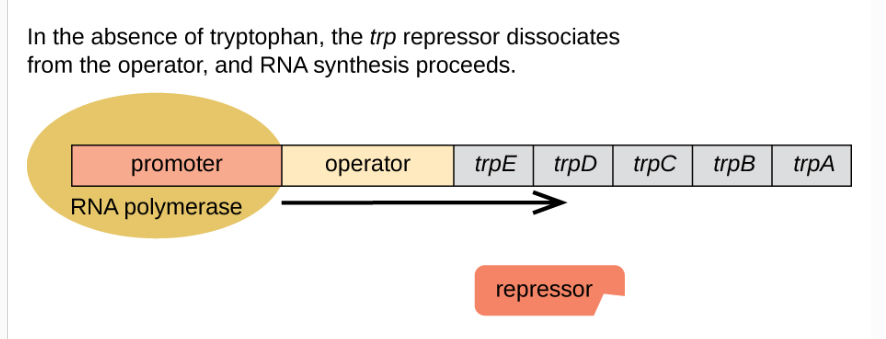
When tRP not present
When tryptophan is not present in the cell, the repressor by itself does not bind to the operator; therefore, the operon is active and tryptophan is synthesized. However, when tryptophan accumulates in the cell, two tryptophan molecules bind to the trp repressor molecule, which changes its shape, allowing it to bind to the trp operator. This binding of the active form of the trp repressor to the operator blocks RNA polymerase from transcribing the structural genes, stopping expression of the operon.

Inducible Operon
An inducible operon is a group of genes that is normally turned OFF, but it can be turned ON (induced) when a specific substance (called an inducer) is present.
Step 1: Operon is OFF by default
A repressor protein is attached to the operator (a part of the operon).
This blocks RNA polymerase from reading the genes.
So the genes are not being used — no proteins are made.
🟩 Step 2: Inducer appears
A small molecule (the inducer) shows up — often the thing the cell wants to break down.
The inducer binds to the repressor.
This changes the shape of the repressor, so it falls off the DNA.
Now RNA polymerase can read the genes and make the needed proteins.
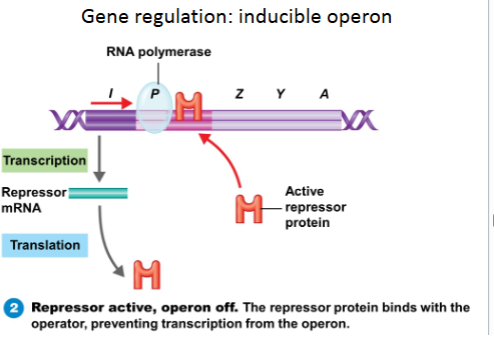
Inducer - Lac Operon example
Found in E.coli
The lac operon encodes three structural genes necessary to acquire and process the disaccharide lactose from the environment
lactose must be present. This makes sense for the cell because it would be energetically wasteful to create the enzymes to process lactose if lactose was not available.
In the absence of lactose, the lac repressor is bound to the operator region of the lac operon, physically preventing RNA polymerase from transcribing the structural genes.
when lactose is present, the lactose inside the cell is converted to allolactose. Allolactose serves as an inducer molecule, binding to the repressor and changing its shape so that it is no longer able to bind to the operator DNA.
Removal of the repressor in the presence of lactose allows RNA polymerase to move through the operator region and begin transcription of the lac structural genes.
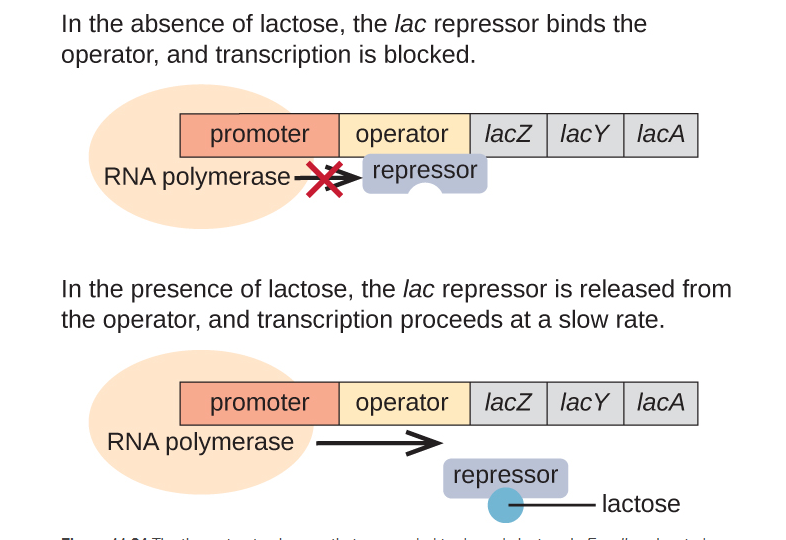
Lac Operon activation depends on glycose levels
Glycose is the preferred sugar by Bacteria
Bacteria grows quickly on glucose
When no glucose is present it is that bacteria will began to consume other sugars like lactose
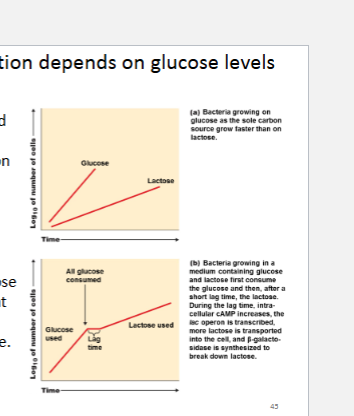
Positive regulation by cAMP
cAMP (cyclic adenosine monophosphate) is a small signaling molecule in cells.
In bacteria, it helps cells respond to low levels of glucose, the cell’s preferred energy source.
When cell consumes all glucose, concentrations of cyclic AMP (cAMP) builds up in the cell
CAP proteins bound by cAMP which allows CAP to bind the promoter to help RNA polymerase to bind and transcribe
When glucose is low:
cAMP levels go up.
cAMP binds to CAP, forming the cAMP-CAP complex.
This complex binds near the lac promoter.
It helps RNA polymerase bind better, so transcription of the lac genes increases.
If lactose is also present, the repressor is removed → lac operon turns ON fully.
🛑 When glucose is high:
cAMP levels are low.
No cAMP → CAP can't bind the DNA.
RNA polymerase doesn’t bind well → lac operon stays mostly OFF, even if lactose is there.

cAMP
Signal glucose availability
High [Glucose = Low [cAMP]
Low [Glucose] = High [cAMP]
CAP = Catabolite (Activator Protein)
Helps RNA polymerase transcribe needs [cAMP]
CAP is inactive without [cAMP]
Bacteria acquire new genes?
Mutations - Alterations of genetic material already present in cell
Genetic Recombination - Gain new genetic material from another through horizontal gene transfer
Mutations
Can alter genes
Mutations- are permanent changes in the base sequence of DNA this even could alter a genes function
Point Mutations - are mutations that change one ( or a few) nucleotides base within the DNA sequence
One (or two) nucleotides are
incorrectly inserted or
deleted from the DNA
sequence, which leads to a
shift in the reading frame
(frameshift).
Spontaneous Mutations - occur in the absence of mutations causing agents
DNA Replication
Mutagens ( things that directly or indirectly cause mutations)
-Chemicals (nitrous acid)
-Radiation ( ultraviolet)
Eukaryotes vs. Bacteria
Most Eukaryotes : Forming new organisms and genetic recombination are linked together ( sexual reproduction and meiosis)
Bacteria: Forming new organisms and genetic recombination are NOT linked ( asexual reproduction and occasional genetic recombination)
Recombination
Genetic information can be transferred horizontally between cells of the same generation
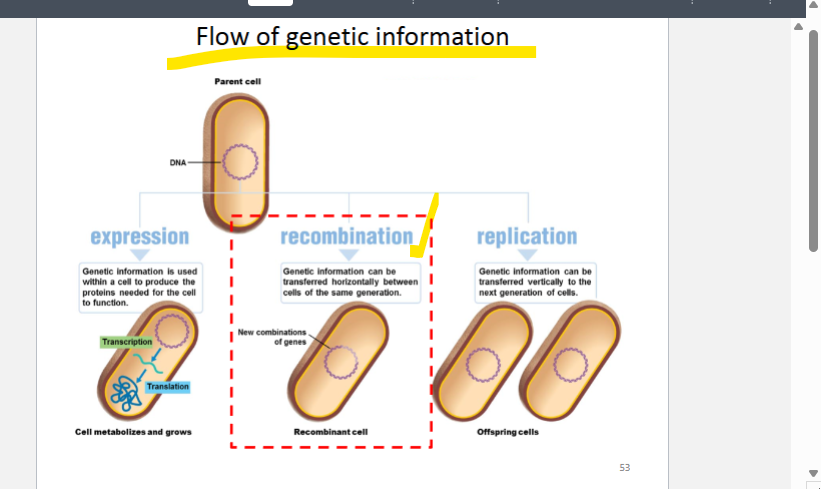
Vertical Gene Transfer | in Bacteria
Binary fission
mother cell passes genetic information to two daughter cells
Different generations
Horizontal Gene Transfer | in Bacteria
Exchange of genes between existing bacteria
same generation
3 Majors of Horizontal Gene Transfer
Transformation
Transduction
Conjugation
Transformation
Cells take up exogenous (outside) DNA from it’s environment
-Genetic recombination (exchange of DNA to form new combination of genes) occur to incorporate new DNA.
** transfers DNA from the outside
not many can do this
happens naturally
Recipient cell must be competent - its in a special physiological state to uptake DNA
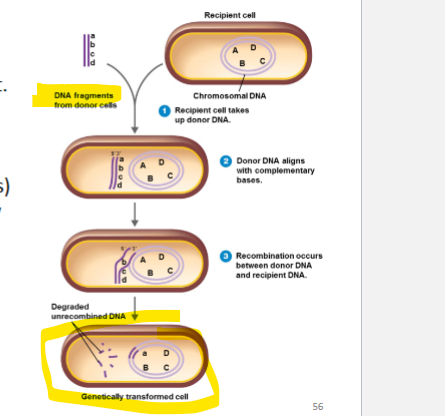
Transduction is transfer of DNA by viruses
Transduction is the viral transfer of genetic material from one bacterium to another
DNA transfer to host bacterium via Phage- accidentally packaged piece of previous host chromosome
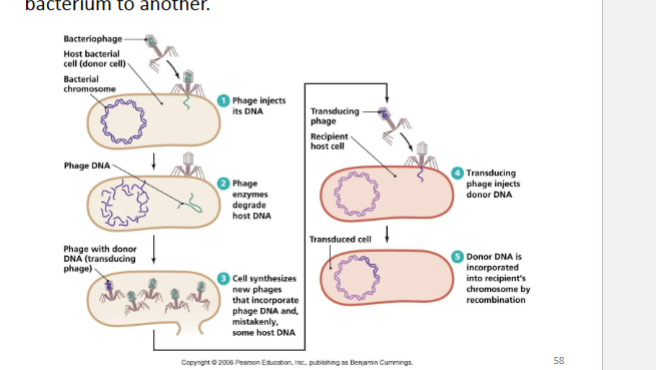
Phages ( Bacteriophages)
Phages normally infect bacteria to replicate and produce more phages
Sometimes the phages package the wrong, DNA ( fragments of the bacterial host chromosome) which result in transduction


Conjugation “mating” bacteria
Conjugation is the transfer of genetic material in the form of a plasmid from one bacterium to another through sex pilus
The sex pilus is a physical connection between the two bacteria
“ Cell - to - cell”
Donor Bacteria cell will transfer plasma recipient bacteria cell via sex pilus conjugation bridge.
a plasmid is a small, circular DNA molecule that can be transferred from one bacterium to another self-replicating, gene-containing piece of DNA
(about 1-5% of the size of a chromosome) that exists outside
of the chromosome.
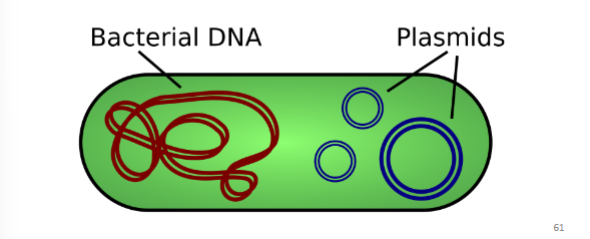
Plasmid Transfers
Plasmid transfers from donor to recipient
Cells are the opposite mating type
Donor ( F+) carries plasmid and recipient (F-) does not
** the recipient will always be the one that doesn’t carry the plasmid

CRISPR
Clustered Regularly Interspaced Short Palindromic Repeats
Adaptive immune system within prokaryotes that defend them against phages
Bacteria gain immunity against phages using CRISPR
Biologist took the system and used it for foundation for an entirely new gene editing tool potential to revolutionize the world and future
How to gene edit using CRISPR
is a system like a precise molecular scissors that cuts exactly where you want it to so you can change the gene you want.
“ you can do it your way’

Growth of Microbes
Growth refers to an increase in the numbers of cells not an increase in cell size
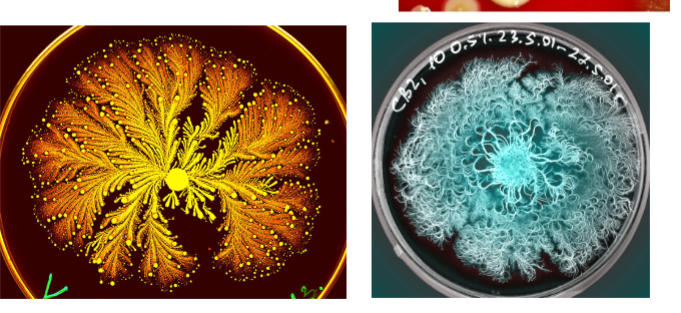
Prokaryotes Grow
Grow by Binary Fission
grows and increases its cellular components

Temp range
Minimum temperature of growth = lowest temperature at
which there is growth (below this temperature, there is no
growth).
• Maximum temperature of growth = highest temperature at
which there is growth (above this temperature, there is no
growth).
• Optimum temperature of growth = temperature at which
there is the most/best growth (allows the highest rate of cell
division to occur).
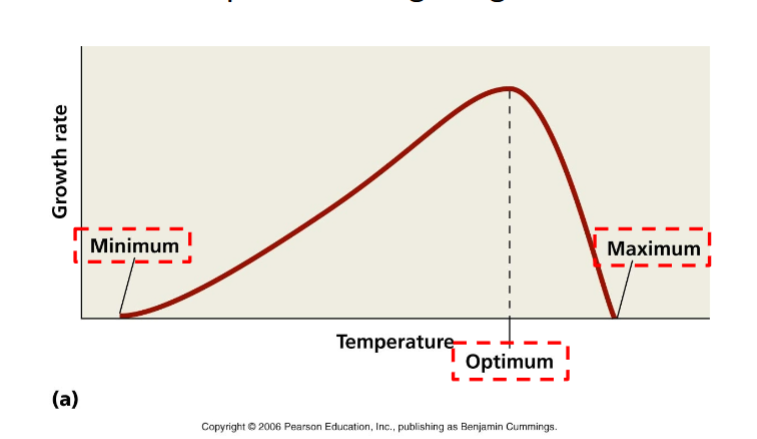
Classification for Temp.
Psychrophiles – Microbes that can grow from below 0°C to a maximum of
20°C. Optimal temperature = 15°C.
Psychrotrophs – Microbes that grow at temperatures of 4°C to 25°C.
Responsible for spoiling food in the fridge.
Mesophiles – Microbes that are adapted to temperatures of 15°C - 45°C
(like the human body).
Thermophiles – Microbes growing at 50°C - 80°C (like hot springs)
Extreme Thermophiles (Hyperthermophiles)– Microbes that can survive at
temperatures from 80°C - 110°C (like deep ocean thermal vents).
Thermoduric – Microbes that are generally mesophilic and are able to
survive at high temperatures (70°C or higher) for short periods of time.
11
Microbes are limited by temp.
At high temperature, enzymes denature and membranes
become more fluid (likely to rupture).
At freezing temperatures, growth is inhibited by reduced
enzyme activity (or denaturation), increase in fluid viscosity,
and membrane rigidity
Microbes tolerate osmotic stresses
Having enough water is important for any cell.
Bacteria maintain relatively high cytoplasmic solute
concentrations which promotes the inward diffusion of water
into the cell by osmosis.
Osmosis is the movement of water across a semi-permeable
membrane, and it occurs as a result of the different solute
concentrations on either side of this membrane.
The result is a more equal solute
concentration on both sides of the
membrane
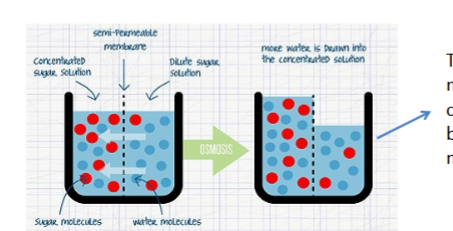
Hypotonic & Hypertonic Tolerate osmotic stress
Hypotonic Environment
Not Harmful to bacteria
Hypertonic Environment
Most bacteria shrivel ( due to plasmolysis) and stop dividing
inhibit bacteria growth
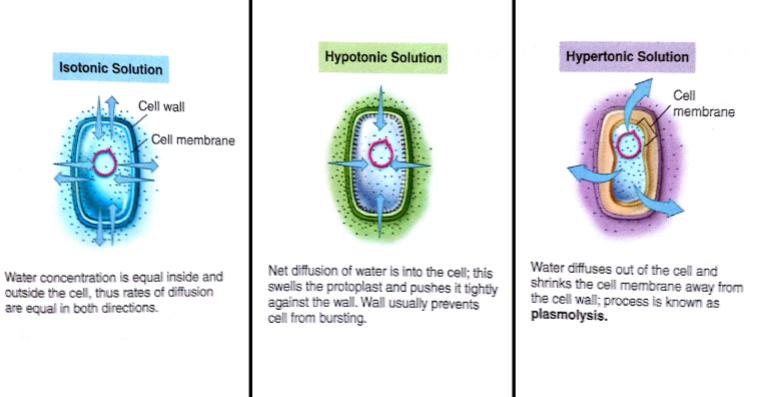
Hypertonic Environment Growth
Bacteria can survive high osmotic pressure by increasing the solute concentration of their cytoplasm
Halotolerant: Bacteria are those that can withstand high osmotic pressure exerted by salt
Halophilic : Bacteria are those that REQUIRE high concentrations of salt to survive

Microorganisms Classification for Osmotic Conditions
Halophiles – Microbes adapted to live and grow only in high salinity
(hypertonic), about 5 – 15%. Most are Archaea, but some are bacteria.
Extreme Halophiles – Microbes that can only grow in 15% - 30% saline
environments (like the Dead Sea and the Great Salt Lake).
Halotolerant – Microbes that can survive and grow in slightly higher saline
environments, from 0 - 11% salinity
Osmophiles – Microbes that can tolerate very high sugar concentrations
(high osmotic pressures). Water activity is not always determined by salt.
Water activity only relates to the solute concentration (and solutes can be
salt, sugars, amino acids, or other molecules).
Microorganism classification for osmotic conditions
*Halotolerant bacteria like S. aureus and B. cereus can grow in salty foods, produce
toxins, and cause food poisoning.*

pH and microbial growth
-measurement of the concentration of H+ in a solution
The HIGHER the concentration of H+ the lower the pH
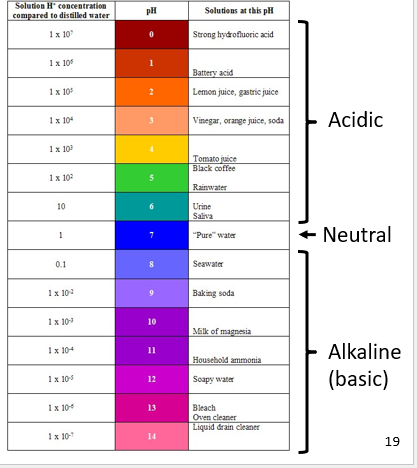
Acidophiles | classification of pH
optimal growth at less than pH of 5.5
Neutrophiles
Optimal growth at range of pH 6-8
Alkaliphiles | classification of pH
optimal growth at pH of 8-10.5
Oxygen Requirements for Microbes
1. Strict Aerobes – Microbes that rely solely on oxygen as the final electron acceptor for cellular respiration to produce ATP.
2. Facultative Anaerobes – Microbes that can use oxygen but do not require it and are capable of growing in the absence of oxygen.
3. Strict Anaerobes – Microbes that cannot grow in the presence of oxygen at all. Rely on fermentation and/or anaerobic respiration to make ATP.
4. Aerotolerant – Microbes that can tolerate the presence of oxygen but do not use oxygen to make ATP.
5. Microaerophilic – Microbes that require oxygen to grow but cannot tolerate high concentrations of oxygen.
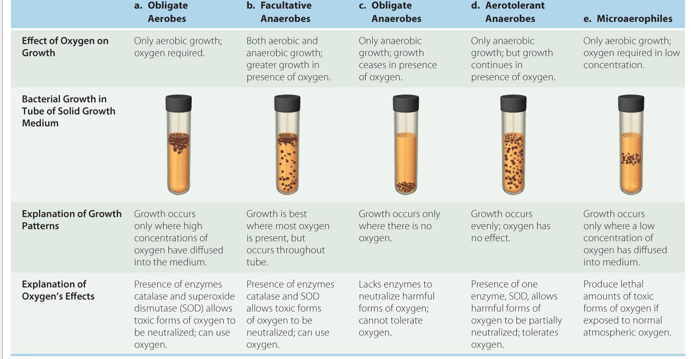
ROS ( Reactive Oxygen Species)
"These are very reactive ions and molecules formed when oxygen is only partly reduced. They can damage almost any large molecule or structure they touch."
Oxygen (O2) reacts with other molecules in the cell to produce toxic forms of oxygen called reactive oxygen species (ROS).
Toxic and Harmful to cells - the result of the oxygen not complete
Cell need enzymes to inactivate break down
Eliminating the harm of ROS
Enzymes and vitamins can detoxify ROS molecules in the cell
Superoxide dismutase
Catalase
Peroxidase
Vitamin C
Vitamin E
4 Groups of Marcos
Nitrogen
Carbon
Hydrogen
Oxygen
Phosphorus
Sulfur
CHONPS **
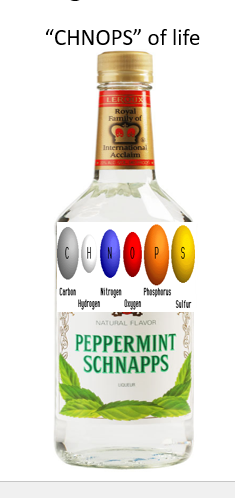
Trace Elements
Cell Requires very little of them
Sodium, Potassium Chlorine, Magnesium , Calcium Iron
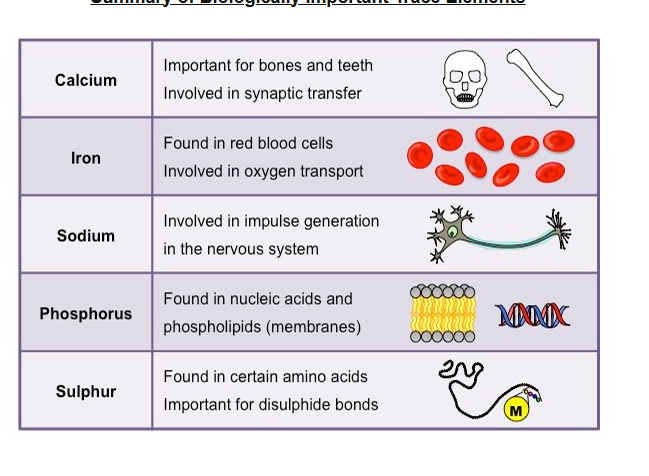
4 STAGES of bacteria Growth
1 Lag Phase
No increase in number of living bacteria cells
2 Log Phase
Exponential increase in number of living bacteria cells
3 Stationary Phase
Plateau in number of living bacteria cells, rate of cell division and death roughly equal
4 Death or decline Phase
Exponential decrease in number of living bacteria cells
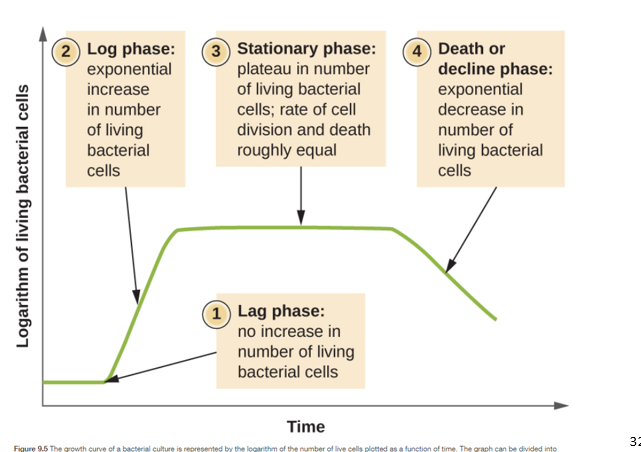
Growth of Bacteria FORMULA
N = number of cells at any generation
N0 = is the starting of number cells
Exponent n is the number of generations

